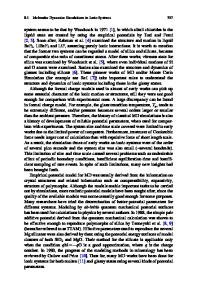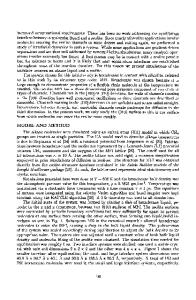Insights into Radiation Tolerance of Ceramics from Large Scale Molecular Dynamics Simulations
- PDF / 2,181,247 Bytes
- 15 Pages / 538 x 718 pts Page_size
- 72 Downloads / 283 Views
1043-T06-03-E06-03
Insights into Radiation Tolerance of Ceramics from Large Scale Molecular Dynamics Simulations
Ram Devanathan and William J. Weber and Materials Sciences Division © 2008Chemical Materials Research Society Pacific Northwest National Laboratory, Richland, WA
Motivation Fundamental study of defect phenomena in ceramics
Issues: We are interested in defect processes in: Nuclear fuels and inert matrices Ceramic nuclear waste forms
© 2008 Materials Research Society We need to understand fundamentals of defect production and annealing. Why are some ceramics more radiation tolerant than others?
R. Devanathan and W. J. Weber
2
Scope Comparison of primary damage state produced by heavy ion recoils in ZrO2,YSZ and ZrSiO4 under similar conditions
© 2008 Materials Research Society
R. Devanathan and W. J. Weber 3
Why YSZ? Yttria stabilized zirconia is highly radiation tolerant
·· V Substituting Y2O3 for ZrO2 introduces O
' + V ·· + 2ZrO x x Y O + 2Zr + O → 2Y ©22008 Materials Research 3 Zr O Zr O Society 2 Radiation damage simulations seldom account for pre-existing defects Our work compares pure ZrO2, YSZ and ZrSiO4 R. Devanathan and W. J. Weber 4
Details of our MD simulations 1,117,200 atoms (ZrSiO4) or 1,500,000 atoms (ZrO2) Buckingham potentials1,2 fitted to ZBL repulsive potential3 DL_POLY3 code (parallel MD) NPT equilibration at 300 K for 3 ps. © keV 2008 Research Society 30 Zr orMaterials U recoil along [001], [110] or [111]
NVE simulation for 25 ps 1R.
Devanathan et al, PRB 69:064115 (2004) 2P. K. Schelling et al, J. Am. Ceram. Soc. 84:1609 (2001). 3J. F. Ziegler et al, The stopping and range of ions in matter (Pergamon, NY, 1985).
R. Devanathan and W. J. Weber
5
Atoms displaced by more than 2 Å 30 keV Zr in ZrO2 and YSZ : [001] recoil in ZrO2 : [001]; : [110];
30 keV Zr in ZrSiO4
: [111] YSZ
© 2008 Materials Research Society
# of displacements is comparable. This can be misleading. R. Devanathan and W. J. Weber
6
30 keV Zr recoil in ZrSiO4 at 22 ps # of surviving defects > # of atoms displaced ballistically!
© 2008 Materials Research Society
115 Å x 70 Å Nearly 24% of defects are in amorphous clusters. ~4300 defects survive. R. Devanathan and W. J. Weber
7
30 keV Zr recoil in 10 % YSZ at 24 ps
© 2008 Materials Research Society
A few isolated defects. No defect clusters
R. Devanathan and W. J. Weber
8
30 keV [001] Zr recoil in ZrSiO4
© 2008 Materials Research Society
Defects were defined based on change in CN and neighbor environment Defect accumulation and in-cascade amorphization.
R. Devanathan and W. J. Weber 9
30 keV [001] Zr recoil in ZrO2
© 2008 Materials Research Society
Defects were defined based on occupation of Wigner cells. Remarkable defect recovery; only ~50 defects remain.
R. Devanathan and W. J. Weber 10
30 keV Zr recoils in YSZ
© 2008 Materials Research Society
Anion interstitials in red; Cation interstitials in blue Complete recovery on anion sublattice
R. Devanathan and W. J. Weber 11
30 keV [001] Zr recoil in YSZ at 24 ps
© 2008
Data Loading...










